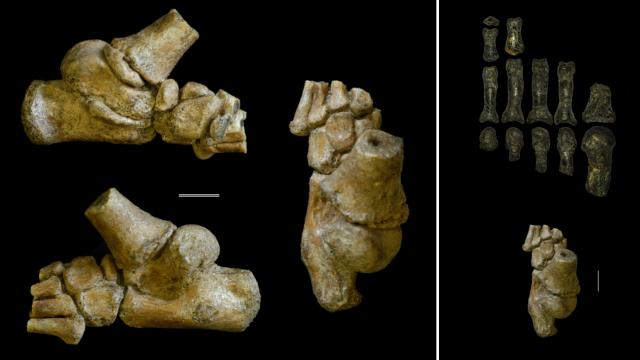A re-analysis of a three-million-year-old fossil suggests Australopithecus afarensis, an early hominid, had children who were as capable on two feet as they were in the trees — an important discovery that’s shedding new light on this critical stage in hominid evolution.
A tiny fossilised foot no larger than a human thumb reveals some of the physical capacities of A. afarensis and their possible behaviours, according to new research published today in Science Advances.
Scientists have long known, or at least suspected, that A. afarensis, an early ape-like hominid that exists somewhere within our family tree, whether directly or through closely related species, walked on two feet.
In fact, some scientists have gone so far as to suggest these ancient great apes were exclusively bipedal, completely forgoing their arboreal ancestry in favour of the heel-toe express.
The new paper, led by Jeremy DeSilva from Dartmouth College, shows that toddler-aged A. afarensis children were capable of standing and walking upright.
Importantly, however, these young hominids still retained the capacity for climbing — an important physical attribute that may have helped them cling to their mothers, climb trees, and escape from predators.

Back in 2002, Zeresenay Alemseged, a professor of organismal biology and anatomy at the University of Chicago and a co-author of the new paper, found the partial fossilised remains of a female infant, around two-and-a-half years old when she died, in the Dikika region of Ethiopia.
The Dikika child, also known as “Selam”, consists of a skull, a nearly complete vertebral column with ribs, shoulder bones, parts of her arms and legs, and the foot, which is considered the most complete foot of an ancient child ever discovered.
“Most of the fossil record consists of adults — it is unusual to find fossilised remains of children, and these give us wonderful insight into growth and development in our ancestors,” DeSilva told Gizmodo.
The fossil was identified as belonging to A. afarensis (the same species as the famous Lucy fossil), and dating back to 3.32 million years ago.
The study released today improves upon the initial 2006 analysis, as many parts of the skeleton, including the partial foot, were encased in sediment. Many of these bones have now been exposed, enabling further analysis of the young specimen.
Analysis of the Dikika child’s foot suggests the infant already possessed the bone structure required for standing and walking — a conclusion consistent with what anthropologists have already learned from footprints found in Laetoli, Tanzania, and from the Lucy fossil, an adult A. afarensis found at Hadar, Ethiopia.
But the foot also exhibits some distinctly ape-like characteristics — features that would have allowed the tot to cling to her mother as she herself climbed through the trees, or as mum fled to safety.
“This foot is very human-like and indicates that the Dikika child was walking on two legs,” DeSilva told Gizmodo.
“However, the bone at the base of our big toe — called the medial cuneiform — has a connection for the big toe that is more curved and slightly more angled than what is found in humans today. Such a curved surface would allow motion of that big toe — which modern apes use for grasping.
“We conclude from this, and from previous studies on the shoulders of the Dikika child, that she would have been able to climb, and to also grasp onto her mother during travel.”
As the researchers point out, the Dikika child’s physical features suggest she was probably a better climber than adults, and that she, like other A. afarensis toddlers, spent more time in trees than her parents.
“They were smaller, probably more playful, and also had to scurry up into the trees to get away from predators more frequently than the adults did,” said DeSilva. “We think that this helps explain the differences we see between the bones of the Dikika toddler and the more human-like bones of the adults.”
Or as the authors write in the study:
The Dikika child was similar in size to a chimpanzee of comparable age and was likely still dependent on and perhaps often actively carried by adults. Given the energetic costs of infant carrying, both adults and juveniles may have benefitted from the [climbing traits] present in the juvenile foot of A. afarensis.
So as A. afarensis was evolving the capacity to walk upright on land, this species, and particularly their children, still retained the ability to climb trees. These dual capacities were likely a very good adaptation in an African ecosystem teeming with dangerous predators.
Inferring behaviours from fossils is a precarious exercise, so these are, at best, educated guesses. More fossils are needed, but that’s proving to be a scarce commodity for this time period.
As noted, the Dikika child lived about 3.32 million years ago, and her fossil was compared to Lucy, which is about 3.2 million years old, and the Laetoli footprints, which are about 3.6 million years old.
“To your readers, these dates may sound like they are roughly in the same ballpark. But, in reality, the Dikika child lived 120,000 years before Lucy; and Lucy lived over 400,000 years after those footprints were made,” said DeSilva.
“Fossils are rare, and these timescales are so vast, we are likely missing a lot that was happening at that time! But, you work with what you have, and make adjustments as new fossils are inevitably discovered.”
